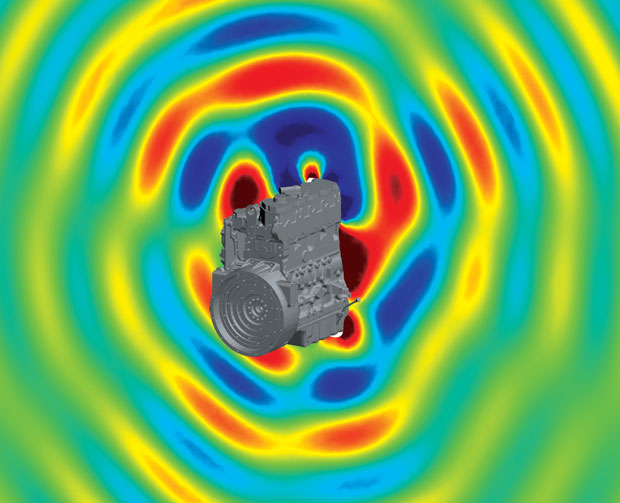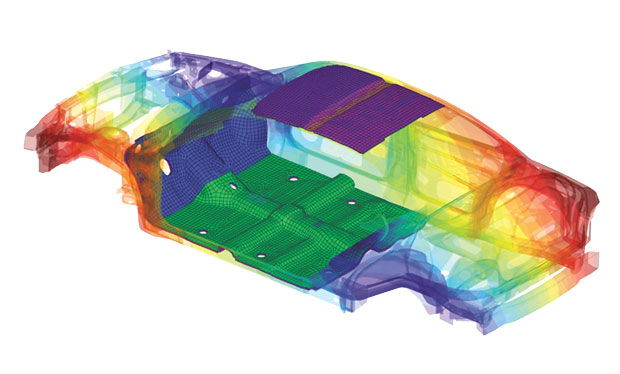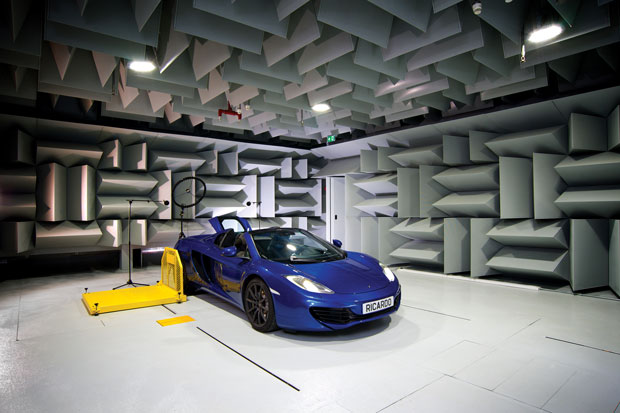
Powertrain acoustic radiation pressure maps help evaluate vehicle noise and vibration. Image courtesy of Free Field Technologies/MSC Software.
Latest News
November 2, 2015
 Powertrain acoustic radiation pressure maps help evaluate vehicle noise and vibration. Image courtesy of Free Field Technologies/MSC Software.
Powertrain acoustic radiation pressure maps help evaluate vehicle noise and vibration. Image courtesy of Free Field Technologies/MSC Software.The pressure is on automakers to make vehicles lighter and more fuel-efficient. While these efforts have resulted in more efficient and eco-friendly vehicles, these engineering changes have created new engineering challenges around controlling noise, vibration and harshness (NVH).
Increased power to weight ratios, engine downsizing and the switch between power sources in hybrid vehicles are creating more audible noise for drivers. Smaller engines generally create more noise and automakers have compounded this issue by adding more turbochargers and superchargers, which further increase NVH problems. New materials like composites and aluminum have also altered the way noise and vibrations pass through the vehicle structure.
“In hybrid vehicles, when you remove the combustion noise, drivers start to hear all sorts of other things, and perceive sounds and vibrations differently. You can even hear fuel sloshing around,” says Paul Weal, technical director at Siemens PLM Software. “There’s another angle to that as well. Pedestrians can’t hear these vehicles, so there are car companies looking for ways to pump noise from the vehicle to warn pedestrians.”
Other changes in vehicle design have also produced new noise and vibration problems. “For example, you could change the material or the structure produced,” says Diego Copiello, senior application engineer and product marketing manager with Free Field Technologies, an MSC company. “This changes the system dynamics, and leads to a possible increase in noise. It’s similar to what is happening in aerospace, where composite materials are replacing aluminum. Changing materials to reduce weight has affected the comfort and noise in the vehicle.”
In the past, automakers responded to NVH issues later in the design process by adding noise-canceling materials or insulation. With an emphasis on lightweighting, however, that approach is impractical.
“Weight is normally good for NVH,” says Simon Tate, NVH manager at Ricardo. “There is a lot of effort involved in maintaining or improving NVH attributes while at the same reducing vehicle mass and cylinder count on the powertrain. There are trade offs.”
Further complicating matters is the subjectivity of many NVH issues; different drivers perceive NVH differently. For example, luxury and economy vehicle owners may perceive noise differently. “There is a whole science behind measuring NVH quality, and some even go to the extent of presenting audio recordings to a jury of drivers,” says Ravi Shankar, director of Simulation Product Marketing for Siemens PLM Software. “There’s not a single metric involved.”
More Simulations, Earlier Simulations
An increase in NVH issues has led to an increase in demand for more simulations, much earlier in the design process. NVH analysis used to be a process that came toward the end of design, at a point when the cost to change the structure of the vehicle was high — now that process has been shifted to the concept stage.
“The strict demand to reach certain targets in terms of weight has led to automakers trying several materials and structural iterations,” Copiello says. “Therefore, they need more simulations. They need to reach a solution faster. We are shifting the acoustic analysis to get the feeling of an object to engineers that previously were not involved in this work.”
“Engineers are applying some tools early on in the design process,” Tate says. “You aren’t applying the Band-Aid of adding mass later in the process. You deal with NVH early on and optimize the powertrain using software tools.”
The process, however, is still the same: “You have to predict or measure the sources of noise, and predict and measure their paths and how those forces and sources are propagating in the vehicle,” Weal says.
“You’re not only predicting what the noise and vibration levels will be, but also understanding why they are increasing, what the paths are, and how to guide designers and analysts in changing the design to improve NVH,” says Mark Donley, NX Nastran product manager at Siemens PLM Software.
 An example of vibro-acoustic analysis of car cavity trim layers. Image courtesy of Free Field Technologies/MSC Software.
An example of vibro-acoustic analysis of car cavity trim layers. Image courtesy of Free Field Technologies/MSC Software.Simulations aren’t just occurring earlier, they are also becoming more complex. Engineers need a view of how changes will affect the entire vehicle design. Multiple simulations have to be linked and conducted simultaneously to accurately measure how noise and vibration will travel through the vehicle. This type of dynamic multi-body system analysis allows engineers to better evaluate variables like engine mounting positions much earlier in the process.
Simulation tool providers have responded by providing ways to speed up the generation of geometries and acoustic meshing. Very early architectural designs have to be cascaded into more 3D simulations, and each part has to be analyzed in the context of the full vehicle. “Building these models has to happen quickly,” Donley says. ” If a component changes, you need to analyze it in the context of the whole system, and you need to be able to build that system model quickly and run the simulation quickly to get feedback.”
Tate says that optimization tools also play a role earlier in the process. “You use those tools to develop structures and apply those optimizations to multiple constraints,” Tate says. “That’s one of the challenges. We’ve been using optimization for many years on single constraints. Now we are developing tools to optimize against multiple constraints.”
Co-Simulation Helps Ford Reduce Drivetrain Noise
Drivetrains are often the source of NVH issues. Lugging is a type of vibration that occurs when a driver accelerates while the vehicle operates in a high gear at a low engine speed. Slipping the transmission can smooth out that acceleration, but at a cost in fuel economy.
Adjusting slip has traditionally been a process that involved more art than science, with a lot of trial and error. Ford Motor Company utilized a co-simulation method to make optimal adjustments without eating up a lot of engineering time using advanced simulation and modeling during the prototyping phase. Ford is using an open standard called Functional Mock-Up Interface (FMI) to combine simulations of the drivetrain, slip controller and full vehicle so that engineers can see how the slip settings affect noise and fuel efficiency.
Ford used MSC Software’s Adams multi-body dynamics solution to create models of the drivetrain and vehicle (that served as the co-simulation master), and the AMESim simulation software to create a 1D model of the torque converter (the co-simulation slave). FMI enables the models to work together in a single simulation. The simulation helped identify an optimal slip of 40 rpm.
“Recent advances in co-simulation have allowed us to use different software to look at those interactions,” Tate says. Ricardo has its own software, VALDYN, for multi-body dynamic and kinematic simulation for valvetrain and drive system analysis. “We use those techniques to develop valve lift profiles for low noise while maintaining the breathing characteristics of the powertrain. That wasn’t possible in the past,” says Tate.
“You need different sets of tools that work together to evaluate those system-level effects,” Weal says. “We’re definitely seeing more use of co-simulation and FMI.”
 Ricardo’s Vehicle Anechoic Test Facility (VATF) at the Shoreham Technical Centre, is designed to help test vehicle noise and vibration while blocking exterior sources. The facility includes a “rolling road” integrated chassis dynamometer. Image courtesy of Ricardo.
Ricardo’s Vehicle Anechoic Test Facility (VATF) at the Shoreham Technical Centre, is designed to help test vehicle noise and vibration while blocking exterior sources. The facility includes a “rolling road” integrated chassis dynamometer. Image courtesy of Ricardo.Quiet Evolution of NVH Fixes
There is only going to be more demand for better NVH analysis and new approaches to reducing noise. Tate says that NVH tools will evolve to provide simpler interfaces and graphics so that engineers and executives who are not acoustics experts can understand the results of the analysis through auralization. “NVH typically relied on complicated looking graphs,” Tate says. “We’re seeing more tools with the ability to communicate how changes in design affect the creation of sound using actual simulated sounds. There are simulation tools that allow you to make changes at the powertrain or chassis level and see and hear how that affects the drive.”
There is also more automation involved. “In these managed environments, the system can identify which parts have changed and automatically reassemble them into a full engine body model much more quickly than before,” Donley says. “Before, it could take weeks to get those models and then find out that the change had negatively impacted NVH performance.”
The human ear is still one of the best instruments for assessing sounds. Many automakers bring in senior management or even customers to listen to real and simulated sounds as part of the NVH analysis process. Some acoustic work can be measured against pre-set decibel levels, for example, but there are regional and brand-based differences in how companies approach these decisions.
“We do set targets and limits for things we can quantify,” Tate says. “We also create ‘images’ of the sound using simulation or distal filters that can be assessed subjectively to see if the sound matches the product expectations.”
Auto manufacturers are also employing discontinuous Galerkin method (DGM) analysis for solving acoustics. “Previously those were available for solving specific aerospace acoustic issues,” Copiello says. “Now these methods are a factor in automotive. Combined with GPU (graphics processing unit) accelerations, DGM can solve pass-by noise problems with simulation.”
Many NVH issues can be addressed through physical alterations, such as adjusting slip (as in the Ford example) or moving the engine mounts. Some noise-canceling solutions take a novel approach. A few automakers have employed active noise control that uses the car audio system to generate sound waves with the same amplitude (but inverted phase) to cancel out low-frequency noise.
Siemens Automotive, for example, created an Active Noise Control system that attaches to plastic air intake manifolds, and can listen to and cancel out unwanted vehicle noises. While the engine is running, the system monitors noise through a microphone. Analog signals pass through an A/D converter to a digital signal processor (DSP), which determines their frequency. The DSP then produces an opposing output signal and sends it to a speaker. The frequency of the output signal cancels the noise of the air intake. This approach would eliminate the need for bulky and costly plastic resonators on the manifold.
The need for more advanced NVH analysis earlier in the design process will continue to accelerate. Six automakers have introduced vehicles with 3-cylinder engines augmented with turbochargers. Consumer acceptance of these vehicles hinges, in part, on how drivers perceive the quality of the ride, and the level of noise and vibration they generate. Solving these NVH issues is critical for the auto industry to produce fuel-efficient cars that consumers will actually buy.
More Info
Subscribe to our FREE magazine, FREE email newsletters or both!
Latest News
About the Author
Brian Albright is the editorial director of Digital Engineering. Contact him at [email protected].
Follow DE




